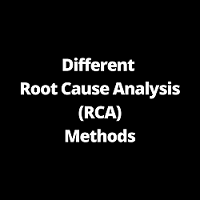There are many root cause analysis methods that will be explained in this article. Before discussing this let us understand why we need the root cause analysis methodology. Root cause analysis is a method that is used to solve a problem for nonconformity so that the root cause of the problem could be found.
The root cause analysis method is used to solve the problem and prevent it from reoccurring. Identifying the root cause of the problem can help the organizations to reduce downtime, eliminate defects, and to optimizes the workforce. RCA helps to improve the overall quality of the product or process and can drive real effective results.
Below are the main points and steps to do the RCA.
- Identify the problem
- Define the problem
- Understand the problem
- Identify root cause
- Corrective or preventive action
- Monitor the system
Root Cause Analysis Significance
Most organizations work on providing short-term solutions. However, relying on short-term solutions will not prevent the breakdown to occur again. If we are fixing the problem on a short-term basis then it will reoccur again and again. There will be a lot of time wastage, and money wastage, and also the productivity will decrease. If industrial organizations want consistent growth then they should focus on the long-term solutions rather than the short-term solutions.
The key steps to consider in root cause analysis are:
- First of all, state the specific problem that you are facing.
- Then collect the data and all the information related to the problem
- After that categorize the possible causes
- Then identify the causes that need to be removed to solve the problem permanently
- Then find out the potential solutions
- After that a plan for implementation to be established
- Finally, review and document that the issue has been properly corrected
Different Root Cause Analysis Methods
There are a lot of tools available but here we will discuss 7 tools which are also known as 7 QC tools. These are given below
- The Ishikawa Fishbone Diagram (IFD)
- Pareto Chart
- 5 Whys
- Failure Mode and Effects Analysis (FMEA)
- Scatter Diagram
- Affinity Diagram
- Fault Tree Analysis (FTA)
We will discuss each Root Cause Analysis Methods one by one:
Fishbone diagrams
The Fishbone diagram is also known as Ishikawa or cause and effect diagram. In this method, a straight line is drawn horizontally. Off this long line, there will be several branches that divide off the primary line. Then each branch has a header and a specific category failure mechanism for identifying the possible causes. The common categories are
- Man
- Machine
- Methods
- Materials
- Measurement,
- Mother Nature- i.e., Environment
Pareto Chart
Practo analysis is a great visual representation of the root cause analysis and it is widely used in industries. The method is used to track and trend the root-cause concern. Pareto Chart generally referred to the 80/20 rule. The Pareto chart appears in a bar graph that displays the values in descending order from left to right totaling the whole charge of the problem. This technique is mostly applied with the quality control concern.
5 Whys
The 5 whys approach to root cause analysis is very basic and the mostly used in industries to identify the root cause. The general purpose of this method is to identify the concern and ask why this failure occurred 5 times. The 5 whys have been taken as a standard but to find out the root cause more why can be added.
The 5 why is typically used directly after a problem occurred and is used on most projects to eliminate the root cause.
FMEA (Failure Mode and Effects Analysis)
Failure mode and effect analysis is a proactive RCA tool that is used to determine the causes and risks of potential failures. In this method, it is discussed in the 3 that how the failure is going to be a girl what will be the severity of the occurrence and how can we detect and solve this issue. Each failure mode is assessed on the following things:
- Severity (S)
- Occurrence (O)
- Detection (D)
A combination of all these three scores produces a Risk Priority number which is also called RPN number. The more weightage is given to the problem which is having the more RPM number and we’ll get the attention first.
Scatter Diagram
A Scatter diagram is also known as a scatter plot and is a graph having two variables plotted along the two axes. Then the pattern of the resulting point tells the correlation between them.
Draw the scatter plot diagram, the dependent variable is plotted along the y axis and the respected course is plotted along the x-axis. If the pattern reveals a clear curve then it is clear that they are correlated.
Affinity Diagram
Affinity Diagram is also known as KJ Diagram, this model is used to represent the structure of big and complex factors that impact a problem or a situation. Then this divides these factors into smaller classifications so that an exact rules Court could be identified.
Fault Tree Analysis (FTA)
The fault tree analysis method is similar to that of FMEA and is considered the proactive approach to RCA. This technique uses a top-down logical analysis of the problem and evaluates the factors that caused the problem.
Frequently Asked Questions
What is RCA?
Root cause analysis is a method that is used to solve a problem for nonconformity so that the root cause of the problem could be found.
What are different Root Cause Analysis Methods?
The different Root Cause Analysis Methods are:
1. The Ishikawa Fishbone Diagram (IFD)
2. Pareto Chart
3. 5 Whys
4. Failure Mode and Effects Analysis (FMEA)
5. Scatter Diagram
6. Affinity Diagram
7. Fault Tree Analysis (FTA)
So, which Root Cause Analysis Methods do you use the most?
Also, read about OEE
